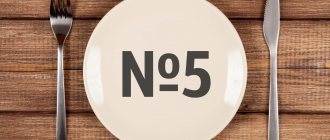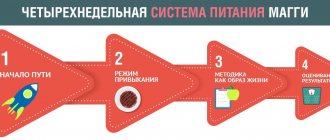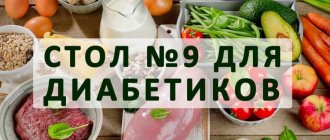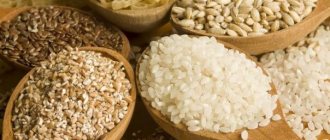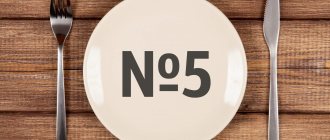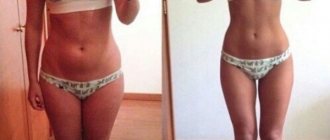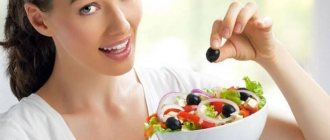11/27/2019 Article
- general characteristics
- Table "Do's and Don'ts"
- Menu for the week
The indication for the use of the “8 table” diet is varying degrees of obesity in conditions of performing mental or physical labor. When prescribing a diet, there should be no complications from the digestive organs, circulatory system and other systems requiring special diets.
General rules
Obesity is a pathology characterized by increased deposition of fat in the body, leading to excess weight. There are many types of obesity, but now we are talking about nutritional obesity, in which obesity is the leading symptom of the disease, and not a consequence or symptom of nervous or primary endocrine diseases (diabetes , hypothyroidism , Itsenko -Cushing syndrome ).
Nutritional obesity develops when calorie intake exceeds the body's energy expenditure and is characterized by a gradual increase in body weight with a relatively uniform distribution of subcutaneous adipose tissue.
There are 4 degrees of obesity:
- at stage I, the actual body weight exceeds the norm by 15-29%;
- at stage II by 30-49%;
- at stage III – by 50-100%;
- at stage IV – more than 100%.
Everyone can determine approximately their normal weight using Brock's formula (height in centimeters minus 100). The fundamental method of treating obesity is diet, combined with physical activity.
The main diet for obesity is a diet with reduced energy value - therapeutic Diet No. 8 ( Table No. 8 according to Pevzner) and its variants 8A and 8o. The level of modification of the energy intensity of the diet is determined by the degree of obesity and the individual energy needs of the patient’s body, taking into account the level of physical activity, age, gender, and labor intensity. The energy value of the main diet varies between 1700-1800 Kcal (90-110 g proteins of which 60% are animal, 80-85 g fats - of which 30% are vegetable and 150 - 170 g carbohydrates); sodium chloride consumption is limited to 5-6 g/day; free liquid - at the level of 1-1.5 liters.
The protein content in the diet should be within normal limits and provide 15–20% of the total calorie intake with a slight predominance of animal proteins. Various types of legumes (peas, lentils, beans) and soy products are mainly used as a source of vegetable protein. Animal proteins are provided by including lean meats (up to 150 g/day) in the diet - veal, beef, chicken, rabbit, turkey, limiting pork and excluding fatty meat (duck, goose), as well as meat products (ham, sausage, canned food) ). Only low-fat varieties of fish are used. It is useful to include seafood (squid, shrimp, mussels).
When compiling a diet, it is important to completely exclude quickly absorbed carbohydrates (sugar, honey, jams, sweets, preserves), which can be replaced with sweeteners ( saccharin , aspartame ). The use of sweeteners ( fructose , xylitol , sorbitol ) that have a sufficiently high energy value is impractical. It is recommended to distribute carbohydrates evenly between all meals. It is recommended to use foods with a low glycemic index in the diet. Bread is limited to 100 g per day or excluded altogether.
In order to create a feeling of fullness in the diet, the consumption of foods containing a lot of dietary fiber (up to 30-40 g/day) is increased - dietary varieties of bread, raw vegetables, fruits, grains, bran (barley, oat and wheat). These products are low in calories and have a large volume.
Fresh cucumbers
Radishes, fresh cucumbers, all types of cabbage, zucchini, pumpkin, turnips, and tomatoes are widely included in the diet, and it is recommended to consume them partially raw. Dishes made from green peas, potatoes, carrots, beets, rutabaga (up to 200 g/day), as well as pickled and salted vegetables are limited.
It is extremely important to control in the diet not only the quantity, but also the quality composition of fat. When limiting fat to 30% of the total daily calorie intake through the use of predominantly low-fat/low-fat foods, it is important to maintain an equal ratio between mono/saturated and polyunsaturated fatty acids. The diet includes low-fat milk and fermented milk products, as well as low-fat cottage cheese, both in its natural form and in the form of puddings, cheesecakes, and casseroles.
Avoid sweet cheeses, cream, fatty cottage cheese, fermented baked milk, fatty cheeses, and baked milk. It is important to avoid including hidden fats in your diet, such as those found in smoked meats, offal, sausages, cheeses, ice cream, nuts, confectionery, and cookies. omega-3 PUFAs in the diet , which are rich in flaxseed and soybean oil, halibut, and capelin.
It is important to provide the diet with sufficient content and ratio of minerals and trace elements, vitamins . It is extremely useful to include foods rich in potassium salts (seafood, soybeans, potatoes, beans, dried fruits, cabbage, black currants, apricots) and magnesium (buckwheat, carrots, rose hips, bran), iodine (seafood, seaweed), antioxidant vitamins ( E , A , C ) - vegetable oils, rosehip decoction, fruits, berries and vegetables.
Salt intake is limited to 5 g/day. At the same time, in the presence of severe persistent hypertension , salt may not be added to food.
All foods that stimulate the appetite (savory snacks, seasonings, strong broths and sauces), as well as alcoholic drinks, are excluded from the diet.
Drinking regimen - 1.5 liters on average per day in the form of mineral and drinking water, herbal teas, unsweetened fruit, vegetable and berry juices. It is recommended to drink water when you feel hungry, which helps suppress it for a while.
Against the background of the diet, it is recommended to carry out fasting days (fruit and vegetable, cottage cheese and kefir) 1-3 times a week. Culinary processing of products involves cooking food mainly boiled, steamed and stewed using appropriate technologies.
The essence of the diet
The Pevzner table for obesity aims to reduce and stabilize the patient’s weight, which has increased as a result of disruptions in metabolic processes and the presence of bad eating habits. Therapeutic nutrition organizes the gradual elimination of extra pounds with tangible health benefits:
- Lipid metabolism in the body is restored;
- Blood sugar levels decrease;
- Blood pressure stabilizes;
- Cholesterol is normalized.
Table No. 8 in terms of energy value ranges from 1700-2000 calories per day. It is by reducing the calories consumed that a person begins to lose weight.
Chemical composition of the daily diet:
- 150-200 grams of carbohydrates (10-15 grams of sugar);
- 90-100 grams of protein (60% animals);
- 80-90 grams of fat (30% vegetable).
The volume of free liquid is limited; it should not exceed 1.5 liters per day, since liquid can activate taste buds and awaken appetite. The amount of table salt varies within 4-7 grams of the daily requirement; nutritionists often prescribe a completely bland menu. Thanks to such restrictions, it will be possible to normalize water-salt metabolism, which is usually disturbed in obesity.
The duration of therapeutic nutrition can last from a couple of weeks to a couple of months. The diet is useful not only for severe obesity, but also as a preventive measure for those who are predisposed to gaining excess weight.
Table No. 8 can be observed only in the absence of diseases of the liver, circulatory system and gastrointestinal tract - in these cases the menu is subject to adjustment.
Varieties
At higher (3-4) degrees of obesity, varieties of Diet 8 with reduced energy consumption of the diet are prescribed.
Diet No. 8A - energy value is reduced to 1200-1300 Kcal (proteins -80 g, of which up to 70% are of animal origin; fats -60 g, of which 30-35% are vegetable fats and carbohydrates - 130 g). Fats are limited mainly due to vegetable fats and carbohydrates by excluding simple and limiting complex carbohydrates. Free fluid intake is reduced to 0.8–1.2 l/day.
If Diets No. 8 and 8A are insufficiently effective (for grade III-IV obesity), Diet No. 8o . Energy value is 600-800 Kcal (40-50 g - proteins; 30-40 g - fats and 50-70 g - carbohydrates). It is prescribed for a short period (up to one month) and is carried out only under the supervision of doctors in a hospital.
At the same time, fasting days per week are practiced: apple (up to 1.5 kg of apples/day), cottage cheese (500 grams of low-fat cottage cheese with 2-3 glasses of green tea), watermelon (up to 1.5-2 kg of watermelon pulp), kefir (1.5 liters of kefir/day) and others).
When using Diets 8A and 8o , you should not start fasting immediately with very low-calorie diets. Start with a moderately reduced Diet No. 8 and then gradually switch to low-energy diets. This will allow the body to gradually adapt to a low-calorie diet and avoid such a phenomenon as “food depression.”
When prescribing low-calorie diets, it is necessary to monitor not only weight, but also the general condition of the body. If side effects appear, such as high fatigue, weakness, nausea , cold intolerance, the characteristic odor of acetone, diarrhea / constipation , dry skin, dysmenorrhea / amenorrhea , heart rhythm disturbances, it is necessary to begin exiting such a diet.
Types of diet
Medical nutrition "Table 8" has two additional subtypes No. 8A and No. 8B:
- Table No. 8A for weight loss is prescribed to patients who do not have diseases or complications that require a special diet. The diet involves a more stringent restriction of the caloric content of foods included in the diet - up to 1300 kcal per day.
- Table No. 8B is prescribed for patients with concomitant heart diseases. It differs from the main diet in the complete absence of table salt in portioned foods.
Authorized Products
Bran and black bread are allowed in the diet (up to 100 g/day). Soups are prepared mainly with vegetable broth, and 1-2 times a week soups with weak, low-fat meat or fish broth with the addition of vegetables or potatoes, without salt, are allowed. The meat for the soup is pre-cooked for 10-15 minutes and the resulting broth is drained, after which the “secondary” broth is boiled.
For second courses, lean boiled meat (no more than 100 g/day) of poultry, turkey, rabbit or lean beef is used. From fish, the diet can include up to 150 g of low-fat varieties (pike perch, pike, cod, carp), as well as seafood - shrimp, mussels, squid. Vegetables (cucumbers, tomatoes, various types of cabbage, zucchini and lettuce) are used as a side dish (up to 200 g/day).
Dairy products include yogurt, low-fat milk, kefir, and low-fat cottage cheese in the diet. As snacks, vinaigrettes and salads seasoned with vegetable oil are introduced into the diet.
Drinks in the diet include black and green tea, weak natural coffee, mineral water, sour fruit and berry juices.
Drinks - tea, tea with milk, tomato juice, juices from sour varieties of berries and fruits, alkaline. Total liquid (together with soup, milk, curdled milk, compote, drinks) up to 5-6 glasses per day.
Table of permitted products
| Proteins, g | Fats, g | Carbohydrates, g | Calories, kcal | |
Vegetables and greens | ||||
| greenery | 2,6 | 0,4 | 5,2 | 36 |
| squash caviar | 1,2 | 7,0 | 7,4 | 97 |
| zucchini | 0,6 | 0,3 | 4,6 | 24 |
| broccoli | 3,0 | 0,4 | 5,2 | 28 |
| cauliflower | 2,5 | 0,3 | 5,4 | 30 |
| cucumbers | 0,8 | 0,1 | 2,8 | 15 |
| soybeans | 34,9 | 17,3 | 17,3 | 381 |
| tomatoes | 0,6 | 0,2 | 4,2 | 20 |
Fruits | ||||
| baked sweet and sour apples | 0,5 | 0,5 | 12,3 | 59 |
Cereals and porridges | ||||
| buckwheat | 4,5 | 2,3 | 25,0 | 132 |
| oatmeal with water | 3,0 | 1,7 | 15,0 | 88 |
| wheat bran | 15,1 | 3,8 | 53,6 | 296 |
| rye bran | 11,2 | 3,2 | 32,0 | 221 |
Bakery products | ||||
| whole grain bread | 10,1 | 2,3 | 57,1 | 295 |
Dairy | ||||
| skim milk | 2,0 | 0,1 | 4,8 | 31 |
| kefir product bio balance 0% | 3,2 | 0,1 | 4,5 | 32 |
Cheeses and cottage cheese | ||||
| cottage cheese 0% (low fat) | 16,5 | 0,0 | 1,3 | 71 |
Meat products | ||||
| lean beef | 22,2 | 7,1 | 0,0 | 158 |
| rabbit | 21,0 | 8,0 | 0,0 | 156 |
Bird | ||||
| boiled chicken breast | 29,8 | 1,8 | 0,5 | 137 |
| boiled chicken drumstick | 27,0 | 5,6 | 0,0 | 158 |
| boiled chicken fillet | 30,4 | 3,5 | 0,0 | 153 |
| boiled turkey fillet | 25,0 | 1,0 | — | 130 |
Eggs | ||||
| hard-boiled chicken eggs | 12,9 | 11,6 | 0,8 | 160 |
Fish and seafood | ||||
| boiled fish | 17,3 | 5,0 | 0,0 | 116 |
| squid | 21,2 | 2,8 | 2,0 | 122 |
| shrimps | 22,0 | 1,0 | 0,0 | 97 |
| mussels | 9,1 | 1,5 | 0,0 | 50 |
| zander | 19,2 | 0,7 | — | 84 |
| cod | 17,7 | 0,7 | — | 78 |
| pike | 18,4 | 0,8 | — | 82 |
Oils and fats | ||||
| vegetable oil | 0,0 | 99,0 | 0,0 | 899 |
| linseed oil | 0,0 | 99,8 | 0,0 | 898 |
Non-alcoholic drinks | ||||
| mineral water | 0,0 | 0,0 | 0,0 | — |
| green tea | 0,0 | 0,0 | 0,0 | — |
| black tea | 20,0 | 5,1 | 6,9 | 152 |
Juices and compotes | ||||
| tomato juice | 1,1 | 0,2 | 3,8 | 21 |
| rose hip juice | 0,1 | 0,0 | 17,6 | 70 |
| * data is per 100 g of product | ||||
Foods that are allowed and prohibited during the diet
You can provide a specific diet for endocrine disease on the ninth table in the context of a 7-day plan. Since there are an extremely large number of recipes for dishes that satisfy this principle of nutrition.
First of all, you need to rely on which food products are allowed, which are partially allowed, and which are strictly prohibited.
The 9th table allows eating:
- vegetable soup with low-fat broth;
- soup with mushrooms or fish;
- chicken, low-fat beef, veal, rabbit;
- low-fat fish, shrimp;
- low-fat dairy products;
- porridge from buckwheat, pearl barley, oatmeal, barley;
- vegetables, with the exception of potatoes, raw or stewed, boiled, baked;
- fruits/berries are not sweet;
- teas, coffee (do not add sugar);
- juices from vegetables, drinks from herbs, such as rose hips.
Conditionally permitted products that comply with the nutritional principle are:
- chicken eggs (2 whole for 7 days, egg whites are allowed to be eaten in larger quantities - up to one and a half per day);
- bran bread made from second grade rye/wheat flour;
- potato;
- honey (uncommon).
Strictly prohibited:
- fatty meat and broths based on it;
- any products made from butter or puff pastry;
- pasta;
- sweet and salty milk-based dishes;
- white rice, semolina;
- legumes;
- marinades and pickles;
- jam and sweet fruits (eg bananas);
- soda and alcoholic drinks.
Prohibited Products
Table 9 is designed in such a way that the chemical composition of the dishes is balanced and includes all the nutrients necessary for the normal functioning of the body.
To maintain liver health, table 9 involves consuming foods high in lipotropic substances, that is, stimulating the breakdown of fats.
To stabilize lipid metabolism, the menu must include vegetable fats.
Fully or partially limited products
Products such as wheat bread and bakery products, all types of fatty meat (pork, goose, duck) and meat products from them (ham, sausages, sausages, canned food), as well as fatty fish, pork, beef and confectionery fat are completely excluded from the diet. .
Any strong broths based on meat, fish and mushrooms, fried, salted and smoked foods, fried eggs, fatty cottage cheese, cream, sweet yogurt, sweet cheeses, baked milk, fermented baked milk, salty and fatty cheeses are excluded. It is not allowed to include rice, legumes, oatmeal and semolina, pasta, spicy and fatty snacks, spices and mayonnaise in the diet.
Bananas, dates, grapes, figs, raisins and sweet varieties of other fruits are prohibited. It is not allowed to include confectionery, chocolate, sweets, sugar, honey, jam, preserves, ice cream, jelly and any alcohol-containing drinks in the diet.
Foods that stimulate appetite are excluded: horseradish, pepper, mustard, various seasonings and hot fatty sauces. The consumption of salt, butter, green peas, potatoes, carrots, beets, rutabaga (up to 200 g per day), as well as pickled and salted vegetables and mushrooms is limited. As for drinks, all juices from sweet fruits, cocoa, and tea with milk are prohibited.
Table of prohibited products
| Proteins, g | Fats, g | Carbohydrates, g | Calories, kcal | |
Vegetables and greens | ||||
| beans | 6,0 | 0,1 | 8,5 | 57 |
| peas | 6,0 | 0,0 | 9,0 | 60 |
| green peas | 5,0 | 0,2 | 13,8 | 73 |
| fried potato | 2,8 | 9,5 | 23,4 | 192 |
| carrot | 1,3 | 0,1 | 6,9 | 32 |
| beet | 1,5 | 0,1 | 8,8 | 40 |
| beans | 7,8 | 0,5 | 21,5 | 123 |
| horseradish | 3,2 | 0,4 | 10,5 | 56 |
Fruits | ||||
| melon | 0,6 | 0,3 | 7,4 | 33 |
Mushrooms | ||||
| mushrooms | 3,5 | 2,0 | 2,5 | 30 |
Nuts and dried fruits | ||||
| nuts | 15,0 | 40,0 | 20,0 | 500 |
| dried fruits | 2,3 | 0,6 | 68,2 | 286 |
| sunflower seeds | 20,7 | 52,9 | 3,4 | 578 |
Snacks | ||||
| potato chips | 5,5 | 30,0 | 53,0 | 520 |
Cereals and porridges | ||||
| white rice | 6,7 | 0,7 | 78,9 | 344 |
Flour and pasta | ||||
| pasta | 10,4 | 1,1 | 69,7 | 337 |
| noodles | 12,0 | 3,7 | 60,1 | 322 |
| pancakes | 6,1 | 12,3 | 26,0 | 233 |
| vareniki | 7,6 | 2,3 | 18,7 | 155 |
| pancakes | 6,3 | 7,3 | 51,4 | 294 |
| dumplings | 11,9 | 12,4 | 29,0 | 275 |
Bakery products | ||||
| bagels | 16,0 | 1,0 | 70,0 | 336 |
| white bread crackers | 11,2 | 1,4 | 72,2 | 331 |
| wheat bread | 8,1 | 1,0 | 48,8 | 242 |
Confectionery | ||||
| jam | 0,3 | 0,2 | 63,0 | 263 |
| candies | 4,3 | 19,8 | 67,5 | 453 |
Cakes | ||||
| cake | 4,4 | 23,4 | 45,2 | 407 |
Chocolate | ||||
| chocolate | 5,4 | 35,3 | 56,5 | 544 |
Raw materials and seasonings | ||||
| mustard | 5,7 | 6,4 | 22,0 | 162 |
| ginger | 1,8 | 0,8 | 15,8 | 80 |
| mayonnaise | 2,4 | 67,0 | 3,9 | 627 |
| honey | 0,8 | 0,0 | 81,5 | 329 |
| sugar | 0,0 | 0,0 | 99,7 | 398 |
| vinegar | 0,0 | 0,0 | 5,0 | 20 |
Dairy | ||||
| milk 3.2% | 2,9 | 3,2 | 4,7 | 59 |
| condensed milk | 7,2 | 8,5 | 56,0 | 320 |
| kefir 3.2% | 2,8 | 3,2 | 4,1 | 56 |
| cream 20% (medium fat content) | 2,8 | 20,0 | 3,7 | 205 |
| cream 35% (fat) | 2,5 | 35,0 | 3,0 | 337 |
| sour cream 25% (classic) | 2,6 | 25,0 | 2,5 | 248 |
| Ryazhenka | 2,8 | 4,0 | 4,2 | 67 |
Cheeses and cottage cheese | ||||
| cheese | 24,1 | 29,5 | 0,3 | 363 |
| cottage cheese 18% (fat) | 14,0 | 18,0 | 2,8 | 232 |
Meat products | ||||
| fatty pork | 11,4 | 49,3 | 0,0 | 489 |
| salo | 2,4 | 89,0 | 0,0 | 797 |
| bacon | 23,0 | 45,0 | 0,0 | 500 |
| ham | 22,6 | 20,9 | 0,0 | 279 |
| pork stew | 13,0 | 35,0 | 0,0 | 367 |
Sausages | ||||
| smoked sausage | 28,2 | 27,5 | 0,0 | 360 |
Bird | ||||
| fried chicken | 26,0 | 12,0 | 0,0 | 210 |
| duck | 16,5 | 61,2 | 0,0 | 346 |
| goose | 16,1 | 33,3 | 0,0 | 364 |
Eggs | ||||
| fried egg | 11,9 | 15,3 | 0,7 | 192 |
Fish and seafood | ||||
| pink salmon | 20,5 | 6,5 | 0,0 | 142 |
| Red caviar | 32,0 | 15,0 | 0,0 | 263 |
| cod roe | 24,0 | 0,2 | 0,0 | 115 |
| salmon | 19,8 | 6,3 | 0,0 | 142 |
| herring | 16,3 | 10,7 | — | 161 |
| cod (liver in oil) | 4,2 | 65,7 | 1,2 | 613 |
| trout | 19,2 | 2,1 | — | 97 |
Oils and fats | ||||
| peasant unsalted butter | 1,0 | 72,5 | 1,4 | 662 |
| vegetable-fat spread | 0,0 | 40,0 | 0,0 | 360 |
| cod liver oil | 0,0 | 99,8 | 0,0 | 898 |
| solid confectionery fat | 0,0 | 99,8 | 0,0 | 898 |
| rendered pork fat | 0,0 | 99,6 | 0,0 | 896 |
Alcoholic drinks | ||||
| white dessert wine 16% | 0,5 | 0,0 | 16,0 | 153 |
| vodka | 0,0 | 0,0 | 0,1 | 235 |
| cognac | 0,0 | 0,0 | 0,1 | 239 |
| liquor | 0,3 | 1,1 | 17,2 | 242 |
| beer | 0,3 | 0,0 | 4,6 | 42 |
Juices and compotes | ||||
| jelly | 0,2 | 0,0 | 16,7 | 68 |
| * data is per 100 g of product | ||||
What can you eat and what can you not eat on diet number 8?
The Diet 8 menu includes some permitted foods and prohibits a number of them. The diet of such a vegetable table can include pumpkin, cucumbers, tomatoes, salads, spinach, and carrots. From cereals you can eat pearl barley, barley porridge, buckwheat; from meat products, choose only low-fat veal, chicken, and rabbit. Milk and sour milk are also necessary, but only low fat. As for bread, give preference to bran and rye.
Under no circumstances should you include:
- Products containing sugar and sweet fruits;
- Soda, packaged juices, alcoholic drinks;
- White bread, pastries;
- Sausages, sausages, cheeses, smoked meats;
- Milk with a high sugar content or very fatty;
- Canned food, preserves, mayonnaise, ketchup.
Such strict adherence to undesirable foods will lead to the fact that you will lose two to three kilograms per month; your metabolism will become normalized. But it is also worth remembering that diet 8 is contraindicated if there are problems with the cardiovascular system, liver, or gastrointestinal tract.
Example menu
The weekly dietary menu for stage 2 obesity is given below.
Monday
| Breakfast |
|
| Lunch |
|
| Dinner |
|
| Afternoon snack |
|
| Dinner |
|
Tuesday
| Breakfast |
|
| Lunch |
|
| Dinner |
|
| Afternoon snack |
|
| Dinner |
|
Wednesday
| Breakfast |
|
| Lunch |
|
| Dinner |
|
| Afternoon snack |
|
| Dinner |
|
Thursday
| Breakfast |
|
| Lunch |
|
| Dinner |
|
| Afternoon snack |
|
| Dinner |
|
Friday
| Breakfast |
|
| Lunch |
|
| Dinner |
|
| Afternoon snack |
|
| Dinner |
|
Saturday
| Breakfast |
|
| Lunch |
|
| Dinner |
|
| Afternoon snack |
|
| Dinner |
|
Sunday
| Breakfast |
|
| Lunch |
|
| Dinner |
|
| Afternoon snack |
|
| Dinner |
|
Diet 8A with insufficiently effective weight loss , the weekly menu for the set of products is not fundamentally different. The main difference is the reduction in the amount of consumption of almost all products. Thus, the amount of meat and fish is reduced to 80 g per day, the consumption of cereals and vegetable oil is reduced.
Below is an example of Diet No. 8A for one day:
| Breakfast |
|
| Lunch |
|
| Dinner |
|
| Afternoon snack |
|
| Dinner |
|
Diet for children
Overweight children should not be given sweet fruit drinks, compotes and cocktails.
They are replaced with freshly squeezed juices and dried fruit compotes without sugar. It is recommended to eat sweet and sour fruits and berries. The child's main diet consists of pureed soups and vegetable dishes. All food should be boiled or steamed. Cereals, legumes and potatoes are consumed in limited quantities. Preference is given to buckwheat and millet porridge. Adding bran to food has a beneficial effect on treatment.
It is forbidden to give an obese child sweet desserts and confectionery, baked goods made from wheat flour, sweet and carbonated drinks. Instead of sugar, xylitol is added to tea, but not more than 25 g per day.
Feeding the baby is divided into 5 meals, in small portions. The main part of the daily diet occurs in the first half of the day, the last meal is 2.5-3 hours before bedtime.
Food for the child.
For children
Primary obesity in children is in most cases caused by overeating and lack of exercise. Parents systematically overfeed their children with high-calorie foods, abusing easily digestible carbohydrates (sweets, white bread, sugar, confectionery, potatoes) and animal fats (butter creams, fatty meats, rich soups). Therefore, in the presence of obesity of any degree, the child, first of all, needs to organize nutrition that corresponds to his physiological norms, taking into account the degree of obesity. At the same time, no matter the degree of obesity, the child cannot be immediately transferred to a strict diet.
It is important to determine whether the child’s weight gain has stopped with food restriction. If yes, then after a short period of adaptation you can gradually transfer him to a more strict diet. And the higher the degree of obesity, the longer the adaptation period should be. With 1-2 degrees of obesity, therapeutic nutrition can be carried out in a family setting, and with 3-4 degrees it is recommended to be treated in a hospital setting.
The basis is dietary Table No. 8 for children. Despite the generality of principles, diet table number 8 for obese children has some specifics that should be taken into account. First of all, the energy value of the diet is adjusted taking into account age, quantitative and qualitative standards, physical development and mobility of the child.
The reduction in energy value is carried out by reducing the content of mainly carbohydrates and partly animal fats in the diet. At the same time, the amount of protein in the diet should always correspond to age standards. The weekly menu of Diet No. 8 for obesity should include lean meats and fish, vegetables, herbs, eggs, unsweetened fruits, low-calorie dairy products in various combinations.
Refined carbohydrates, flour, pasta and confectionery products should be completely excluded. Only wholemeal bread is allowed. Each week should include at least 2 fasting days. The duration of therapeutic nutrition is from one to several months.
Diabetes mellitus, nutritional features
Very often, a significant increase in body weight is a consequence of a diagnosis such as type 2 diabetes. Table No. 8 is often one of the main components of complex treatment of the disease, which, if strictly followed, does not even require drug therapy.
During the diet, patients learn to control the size of portions consumed and instill proper eating habits.
For patients diagnosed with diabetes, in parallel with a low-calorie diet, the doctor prescribes mandatory physical activity. Their activity is regulated depending on the general condition, lifestyle, percentage of obesity and age of the patient.
Diabetes mellitus in children
A disease such as diabetes manifests itself due to disruptions in the functioning of hormones not only in adults, but also in children of any age.
In the case of a chronic metabolic disorder in a child, the Pevzner table should be followed by the whole family. Diabetes mellitus in children most often occurs due to uncontrolled consumption of sweets, flour and fatty foods. You can’t feed yourself on mashed potatoes in butter, fatty chicken legs and high-calorie cakes, while at the same time “stuffing” boiled chicken breast with broccoli and cucumbers into your child. For children, it is their mothers and fathers who are idols and role models. Therefore, diet No. 8 can only be followed by children together with their parents.
The most difficult thing for children diagnosed with diabetes is giving up sweets. In all large supermarkets there is a special section with diabetic products, where you can sometimes buy sorbitol cookies or fructose chocolate for your child.
Advantages and disadvantages
| pros | Minuses |
|
|
pros
1. Your body will not be subject to severe stress, because it will have enough time to completely get used to the new nutrition system and new lifestyle; 2. In order to maintain the results of the entire diet for a long time, you need to adhere to certain instructions for exiting it. In this case, the lost weight will not return and you will remain in the achieved shape; 3. During the diet, you and your body will completely rebuild all your habits, develop new useful habits, because of which you will adhere to proper nutrition and lifestyle in the future; 4. Due to the sufficient duration of the diet, you will not need to sweat for hours in the gym, because during this period you will have time to lose weight and get in shape without heavy training; 5. Together with your doctor, you can find and select an individual nutrition system for yourself, from those that are designed for no more than a month.
Recipes
Vegetarian cabbage soup
Half a head of fresh cabbage, 2 onions, 2 sweet peppers, 200 g of sauerkraut, 2 carrots, herbs, bay leaf, salt.
Clean everything and chop finely. Place in a container, add water, cook until tender. 5 minutes before readiness, add bay leaf and lightly salt, add herbs before serving.
White omelette with spinach
Half a glass of milk, 3 chicken whites, 30 g suluguni, 70 g spinach (can be frozen), 1 tbsp. l. ghee.
Fry spinach in butter. Add a pinch of salt and milk to the whites and beat thoroughly. Pour the mixture into a heated frying pan and stir. Keep on high heat for 1 minute, add grated cheese, cover with a lid, reduce heat to medium. Cooking time 3-5 minutes.
Vegetable smoothie with celery
1 cucumber, 2 tomatoes, 2 stalks of celery, mineral water, a pinch of cumin.
Wash, peel all vegetables, remove the skin from the cucumber and chop finely. Mix all ingredients together, add mineral water and beat until smooth, add ice.
Dish recipes
Despite the fact that table No. 8 according to Pevzner has a low energy value, from the list of permitted foods you can prepare many hearty, tasty and nutritious dishes, while staying within the permitted caloric intake.
Heat treatment allows for boiling, stewing, baking, steam cooking and very rarely frying until lightly crusted.
First course recipes
Lenten beetroot
Ingredients:
- 1 large beet;
- 2 potatoes;
- 1 carrot;
- 1 onion;
- 2 tbsp. l. tomato paste;
- 2 tbsp. l. vegetable oil;
- A pinch of salt.
Preparation:
Cut the potatoes into small cubes and cook them in a 1.5-2 liter saucepan with water, periodically removing the foam with a slotted spoon. Meanwhile, finely chop the onion, grate the carrots and place in a preheated frying pan with vegetable oil. When the vegetables acquire a golden color, add grated beets with tomato paste and simmer, stirring, until the beets are soft. When the potatoes are cooked, you can fry them. Salt the beetroot soup, let it boil and remove from heat.
Protein recipes
Fish casserole
Ingredients:
- 500 grams of pollock fillet;
- 5 potatoes;
- 2 eggs;
- 4 tbsp. l. sour cream;
- 1 onion;
- 1 carrot;
- 100 grams of hard cheese;
- A sprig of parsley and dill;
- 2 tbsp. l. vegetable oil.
Preparation:
Grease a baking tray with vegetable oil and begin to place all the ingredients on it. The bottom layer will be thinly sliced potatoes (like chips). Then we place the deboned pollock fillet on it. On top of the fish we place onion cut into half rings and carrots grated on a coarse grater. In a separate bowl, beat eggs with sour cream and chopped herbs. Fill the casserole with the egg mixture and place in an oven preheated to 180 degrees for half an hour. After the specified time has passed, take out the dish, sprinkle with grated cheese and put it back in the oven for 10 minutes.
Dessert Recipes
Raspberry soufflé
Ingredients:
- 150 grams of raspberries;
- 5 egg whites;
- 2 tbsp. l. stevia;
- 1 tbsp. l. corn flour;
- ½ tbsp. l. butter;
- A pinch of salt.
Preparation:
Rinse the berries, beat with a blender and rub through a sieve to get rid of grains. Put the berry puree on the fire, add a small amount of water and stevia. Simmer until the sweetener is completely dissolved. Sift the flour and add water to create a corn mixture with the consistency of thick sour cream. Separate the whites from the yolks and beat well with a pinch of salt. Now all the ingredients need to be combined. First, add corn flour to the raspberry puree, mix and only then carefully add the whites. The sequence cannot be broken, otherwise the soufflé will not turn out as fluffy as it should. Place the “dough” in molds greased with butter and place in a preheated oven for 10-15 minutes.
Diet No. 8 according to Pevzner is considered one of the best weight loss methods. Gentle healthy nutrition will allow you to safely and effectively lose extra pounds.
The therapeutic nutrition system does not promise quick results - the weight will decrease gradually, every month by 2-3 kilograms. But the process of losing weight will become easy, the patient will quickly adapt to the new regime, will feel comfortable and will not harm his health.
THESE ARTICLES WILL HELP YOU LOSE WEIGHT
Comments from nutritionists
One of the main mistakes is made by those patients who, due to obesity, strive to lose weight in the shortest possible time. Many physiologically inferior and unbalanced diets (mono-diets) are advertised on the Internet, promising rapid weight loss in case of obesity, however, as practice shows, weight is also quickly restored to the original level, and often exceeds it. At the same time, general well-being often suffers. It is a balanced energy-reduced diet that is much more effective than such diets. And in this regard, the Soviet therapeutic Diet No. 8 according to Pevzner is especially effective. That is, a diet for losing weight should not be hungry.
The timing of diet therapy is individual and depends on many factors, but in any case, dietary therapy involves a long period of being on a diet. It is generally accepted that the normal rate of weight loss is 1% per week of your own weight. An indicator of the correctness of dietary nutrition is not only a decrease in body weight, but also the resulting increase in neuromuscular tone and improvement in overall well-being.
Following a diet without adequate physical activity cannot lead to significant weight loss. Physical activity will help prevent metabolism from adapting to new nutritional conditions, maintain muscle mass and reduce energy balance. However, the load must be exactly adequate to your physiological capabilities, since excessive physical activity has the opposite effect. It is recommended to walk 3-10 km per day, which can be combined with swimming or cycling.
It is extremely important to change eating behavior. Most overweight people view eating as a pleasure and often go to the refrigerator not for the purpose of satiation, but in order to cope with a traumatic/stressful situation or improve their mood, occupy boredom, relieve feelings of loneliness, melancholy, apathy, anxiety , depression . Therefore, in addition to motivation, it is important to have and maintain a certain psychological attitude, for which you need to use group psychotraining, autogenic training, and hypnosis.
Don't set too high goals for yourself. If weight loss occurs through violence against your body with feelings of hunger, discomfort, dissatisfaction with yourself, the result will always be negative, either in the form of a psychological breakdown or in the form of a return of weight to the original level.
Restoring weight to the original one or exceeding the original one during forced weight loss occurs quite often, especially with mono-diets. This phenomenon is called weight cycling and all the links in it condition each other:
- weight loss phase;
- lower plateau - weight no longer decreases, despite all ongoing efforts;
- weight gain phase;
- upper plateau - weight stabilizes again at the original level or slightly higher than the original level.
It is “comfortable” weight loss with a smooth weight loss without jumps that guarantees that the weight will not return again after completing the course.
Diet table No. 8 for obesity: principles
To successfully overcome your excess weight and normalize your appearance and health, you need to adhere to several basic principles of nutrition and lifestyle. You must achieve your goal through a properly formed diet, which must contain all the necessary nutrients. But it should be remembered that achieving the goal must be done through a strong reduction in carbohydrates and animal fats. If you correctly follow all the available instructions and adhere to your diet, you will not only successfully lose excess weight, but also improve your health, become more energetic and resilient.
Diet table No. 8 for obesity is based on several main principles : 1. To lose weight you need to reduce the calorie content of the foods you consume; 2. In order to feel full from food for a long time and normalize the functioning of the gastrointestinal tract, you should pay special attention to products containing plant fibers, try to include them in your diet in the required quantities; 3. All food must be prepared in a special, safe way to preserve all the beneficial substances of the products used; 4. Monitor the amount of liquid you consume; 5. Watch what you eat. There is no need to eat foods that cause an acute feeling of hunger; 6. Eat small, frequent meals. You should have approximately five to six nutritious meals per day.
Rules: 1. Reduce as much as possible the amount of animal fats you consume, as well as fast carbohydrates; 2. Try not to drink more than one and a half liters of liquid per day. Drink only some time before meals, so as not to dilute gastric juice and normalize metabolic processes in the body; 3. Eliminate all high-calorie foods, including foods such as: too sweet and salty foods, spicy and fried foods. 4. Watch how your food is prepared. It must be boiled, stewed, steamed or baked; 5. If your health allows you, then engage in physical activity, but remember that the level of your physical fitness should be directly consistent with the amount of sports in your life; 6. While eating, completely focus on what you are eating, this way the signal from your stomach will quickly reach your brain that you are already full and, accordingly, you will eat several times less than you could. While eating, you should never read, watch TV, or engage in other activities; 7. If you want to play sports, then do it. But don’t exhaust yourself with everyday backbreaking workouts; give your body time to recover and rest; 8. Don't expect quick results right away. This diet is quite long, but thanks to this, the weight will go away forever, but not at all as quickly and rapidly as we would like;
Reviews and results
Reviews about the weight loss results of obese patients on Diet No. 8 are mostly positive. Most patients managed to reduce weight to the planned levels.
- “... I have been struggling with excess weight all my life. I tried all sorts of diets, but almost always the weight returned to its original weight after 1-2 months. When I realized that I was already obese, I turned to specialists. I was on a therapeutic diet for 6 months. My weight is almost back to normal. But I still constantly monitor my weight and as soon as it exceeds my norm by 1-2 kg, I immediately sit down on Table No. 8 with two fasting days.”
Patient reviews
Anna, 26 years old, Kazan: “As a child, I was always chubby, but it didn’t bother me.
When all my friends started families, and men didn’t pay attention to me, this became a problem. Six months ago I learned about diet No. 8 according to Pevzner. The excess weight began to disappear little by little. Before I went on a diet, I weighed 92 kg, now the scales show 81, and, most importantly, the weight remains stable.” Maria, 31 years old, Tuapse: “In my youth I was slim, my weight was always within the range of 54-56 kg. After the birth of my second daughter, I gained 40 kg and for a long time could not return to normal. On the doctor’s advice, I went on the “Table No. 8” diet. After just two months I lost 8 kg. There are no strict restrictions in this diet; it is balanced and quite nutritious, despite the low calorie content of the recommended foods.”
Minuses
1. Not for everyone, a month of abstinence from usual foods and following a strict diet becomes a feasible test, so there are frequent cases when people break off the diet; 2. Moreover, the harder it becomes to follow a diet, the more holidays there are during it, when there are so many temptations and temptations around us; 3. In addition to all of the above, weight does not always come off evenly. Sometimes it may hardly decrease at all, or even stand still. It is because of this that many people who are losing weight give up due to nervousness, lose all motivation to lose weight and stop the diet without achieving any significant results; 4. Losing weight always becomes a sacrifice, which is far from easy to bear.
Diet No. 8: prohibited foods
• Wheat bread made from premium flour, baked goods.
• Soups with cereals, potatoes, legumes and pasta.
• Goose, duck, boiled and smoked sausages, frankfurters, ham and canned products.
• Fatty dairy products (high-fat cottage cheese, sour cream or cream), baked milk, hard cheeses (salty and fatty).
• Fatty, salted and smoked fish, caviar, canned fish in oil.
• Fried eggs.
• Rice, semolina and oatmeal, legume dishes.
• Grapes, bananas and their juices, figs, raisins, dates, confectionery, ice cream, jelly, cocoa.
• Heavy and culinary fats.
• Spicy and fatty sauces, various spices.
